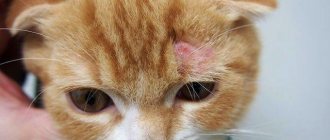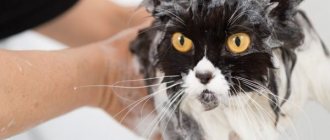Dangerous bacteria
In Australia, an 80-year-old woman died after 9 days in a coma. And, it would seem, there is little extraordinary in such a situation. But a detailed examination revealed that the cause of the coma was the fact that the elderly lady was scratched and licked by her cat. As a result, the woman developed bacterial meningitis, i.e. inflammation of the meninges due to a pathogen of bacterial etiology.
It was the pet that rewarded its owner with the bacterium Pasturella multocida. This pathogen is a rod that is not stable in the external environment and dies when heated or under the influence of ultraviolet radiation. Moreover, such a microbe can survive in soil or manure for 3-4 days.
The infection enters the body through the skin at the site of a bite or scratch left by animals. Inflammation begins in the affected area. But there are also options for hematogenous spread of infection throughout the body.
Protecting yourself from the disease is quite simple in such a situation - you do not need to let animals lick their wounds and other damage to the skin. And if you get a scratch from a claw, you need to treat it with ordinary antiseptics - you can use chlorhexidine or peroxide.
There is no beast more terrible than a cat. Which pets are dangerous for allergy sufferers? Read more
How do you know if you have been infected with COVID-19?
The most reliable solution is to get tested for coronavirus. It is carried out directly in the clinic or at home. In the first case, you will need to visit our laboratory in Rostov-on-Don, in the second, call a doctor to conduct a study at home.
The results will be ready in the shortest possible time . No special preparation is required for the tests: it is enough to refuse food and drinks 3-4 hours before the test. Not only older people and adults, but also children can get tested.
If the tests give a positive result, then further treatment will be developed individually, depending on the form of COVID-19.
Scabies manifestations
Experts note that you can also catch a disease such as scabies from cats. The infection is caused by the mite Sarcoptes scabei. This mite is considered an external parasite of the skin of pets. When the pathogen is transferred to human skin, symptoms such as itching and rash in the form of papules begin to appear. Secondary pustules may appear due to scratching and complications against this background.
Again, banal hygiene decides everything - you need to wash your hands more often after contact with your pet, do not kiss him, give him preventive examinations at the veterinarian on time and give him the necessary vaccinations. Naturally, it is necessary to carry out antiparasitic treatment in a timely manner, which will reduce the risks. And, of course, you should change your pet’s litter box with gloves and thoroughly wash your hands with soap after the procedure.
Ringworm
This is a highly contagious disease. Domestic cats are at risk of catching it from stray animals. A person can become infected simply by petting a sick pet.
The pathogens - Microsporon, Trichophyton - are anthropozoonotic, that is, common to both.
When affected by this fungal infection, redness, peeling, and purulent lesions usually form on the skin of the hands, head and face. Without timely treatment, the affected area grows and hair loss occurs.
A person can bring the fungus into the house on their shoes or hands if they pet a sick street cat.
It is often difficult to determine who the primary and secondary sources of infestation are in a home. Cats, due to their healthy immunity, sometimes act as carriers of ringworm without contracting it themselves.
This fungal infection requires long and persistent treatment. At the first signs of infection, you should immediately contact a specialist.
Modern diagnostic methods make it possible to immediately identify the pathogen and begin active therapy. The prognosis is favorable, lichen is completely cured. To prevent infection of pets and people, preventive measures must be followed.
Aujeszky's disease
This variant of the disease, experts note, is rare. It also has other names - pseudorabies or meningoencephalitis of an infectious nature. The causative agent is the herpes virus. Cats themselves pick up the pathogen when they eat raw meat if the animal was sick. A person receives such a pathogen through the mucous membranes. It is worth remembering that the pathogen is released in the saliva and snot of a sick cat.
After infection with such a pathology, a person may experience the following symptoms: problems with the nervous system in the form of paralysis, itching in the area of the lips, eyes and on the arms and legs, excessive weaving from the nose, increased fearfulness. The pathology is treated with antibiotics and symptomatic therapy, for example taking antipyretics. Moreover, this therapy applies to cats. In humans, everything goes away on its own after 5-7 days. But it’s still better to see a doctor.
Cat and mouse. Can a pet eat caught birds and rodents? More details
Cat scratch disease
This pathology is considered quite well known and quite common. The disease in humans begins due to the entry of the bacterium Bartonella henselae. It is normally found in cats' mouths and is part of the animal's natural microflora. The bacterium enters the human body through licks, scratches, bites and other physical contacts made by the cat. First, a raised red spot appears on the skin - as a rule, it is found at the site of a healed scratch. After a couple of days, it becomes a vesicle with cloudy contents, and then turns into an ulcer. After a maximum of one and a half months, an enlargement of the lymph node closest to the site of the lesion develops.
Additional symptoms include fever, pain in the head, muscles and joints, and decreased appetite. Adults who do not have any chronic diseases recover quickly. Those whose immune systems are not working well may develop complications such as eye infections, as well as heart and brain problems.
Types of infections in cats
There are many known infections that affect the sensitive cat's body. You should know at least the most common of them, since they are the ones that cause serious danger to the health of not only the cat, but also its owner.
It is important for a cat owner to know the symptoms of various infections.
Infectious panleukopenia
This disease is more often called infectious gastroenteritis or plague. It is accompanied by febrile conditions in cats, functional disorders of the digestive tract (diarrhea, eruption of gastric contents), myocardial and vascular insufficiency. In the vast majority of clinical cases, it causes the death of both young and adult cats. The causative agent is parvovirus; it is characterized by a certain seasonality in outbreaks of the disease. Despite the fact that the infection affects all cats, the most susceptible are young animals and kittens, due to the body’s underdeveloped immune defenses. Sick cats and those who have recently recovered from the disease act as a source of viral disease. Along with excrement and gastric effusions, parvovirus is released into the environment. The incubation period ranges from 2 to 10 days. Characteristic signs of infectious gastroenteritis are the animal's apathy, a sharp deterioration in the condition, a rise in temperature (febrile states), vomiting and diarrhea. As the disease progresses, mucus and streaks of blood appear in the stool and gastric contents.
Infectious gastroenteritis is caused by parvovirus
Herpes
Herpes viral rhinotracheitis is often confused with ARVI due to the similarity of symptoms (coughing, sneezing, mucous discharge from the nose and eyes, poor appetite). This common disease occurs everywhere where cats live in crowded conditions and are not vaccinated (shelters, basements, nurseries of unscrupulous breeders).
Herpes affects the mucous membranes
The source of the viral infection is a sick cat. Infection occurs through direct contact of animals with each other. The virus is concentrated in discharge from the eyes, nose, and is present in feces, urine and semen, as well as in utero. Feline herpesvirus rhinotracheitis is highly treatable.
Infectious rhinotracheitis
The source of the pathogen is both sick and recovered cats. The peculiarity of this disease is that many cats who have recovered from the disease become latent virus carriers. Although they do not have clinical symptoms of the disease, the virus “hides” in neurons and ganglia.
Under natural conditions, animals most often become infected aerogenously (especially at exhibitions, nurseries and other crowded places). The virus is released through coughing and sneezing, nasal secretions, eye discharge and other body fluids - infection usually occurs through direct contact with these secretions. Another way of spreading the infection is through contact with objects on which a sick cat has coughed or sneezed: food, bowls, vehicles, hands and clothes of the owner.
Infection with rhinotracheitis occurs through contact with infected secretions.
After entering the respiratory tract, the virus penetrates epithelial cells in which it multiplies. Soon after the virus enters the blood, a fever develops, and then the virus attacks the brain. The virus also affects the reproductive tract and can cause serious complications during pregnancy, leading to abortion and/or stillbirth of a kitten. The course of the disease worsens with mixed infection.
The incubation period is 217 days. The most typical symptoms are: oral ulceration, lack of appetite, depression, fever, purulent conjunctivitis, sometimes bilateral prolapse of the third eyelid, runny nose, diarrhea (usually yellowish-green), excessive drooling, shortness of breath. The disease can be complicated by bronchitis, and in severe cases, pneumonia is possible.
Cat coronavirus
This virus is widespread in the population. The presence of antibodies is detected in 50% of domestic cats and in 90% of cats in shelters and nurseries. A risk factor is crowded housing. Coronavirus is species specific. It may disappear from the body when the overall infectious load decreases (single housing, regular cleaning of the tray) or for other reasons. The route of transmission is the fecal-oral route (sharing a tray with an infected animal). The virus mutates into a fatal disease (FIP) in 5% of cases. Risk factor – stress (any). Keeping healthy and infected animals together in the same space is undesirable.
Coronavirus is very common in the population
Symptoms of coronavirus: diarrhea and vomiting. It may appear once in a lifetime, or occur periodically, or may become severe with a poor prognosis.
Feline calcivirus
An acute infectious viral disease is characterized by fever and damage to the respiratory tract. Animals with strong immune defenses develop stable immunity after suffering a calcivirus infection. The causative agent of the disease is a member of the Caliciviridae family, resistant to temperature. The source of infection is sick animals that release pathogenic microorganisms into the environment along with feces, secretions from the nasal cavities and oral cavity. The period from the penetration of the pathogen into the body until the onset of the first characteristic signs is from 2 to 5 days. Calicivirus infection of cats occurs with similar symptoms to rhinotracheitis, but a distinctive feature is the formation of ulcerative lesions on the tongue, soft palate, and the outer part of the nose. Often accompanied by the development of acute rhinitis, pneumonia and damage to the bronchial tree.
Calcivirosis is characterized by ulcers on the tongue
Chlamydia in cats
A contagious disease that manifests itself in cats as inflammation of the cornea and conjunctivitis. In rare cases, when the body's defenses are low, chlamydia develops into pneumonia. Chlamydia affects not only the respiratory system, but also the genitals. It is important to note that cats with chlamydia infected in the reproductive tract can become infertile as a result of a total breakdown of the structures of the vaginal mucosa. Newborn kittens can die if infected with this infection. When adult animals are infected with chlamydia, swelling of the mucous membrane of the nasal passages and eyes is observed, and pulmonary edema may develop, but this happens extremely rarely. Chlamydia infection occurs when a pet eats mice and rats, which are carriers of the infection.
Conjunctivitis is one of the symptoms of chlamydia
Other infectious diseases of cats
Other fairly common infections in cats include rabies. This is an acute viral disease that occurs with great complications; it affects the nervous system and in the vast majority of cases causes the death of the animal. The main source of rabies is wild animals (foxes, wolves), as well as stray cats and dogs. When a rabid animal bites, the virus penetrates the skin along with saliva. The incubation period is from 3 to 6 weeks, and in small kittens no more than 5 days. It is noteworthy that in an animal 8 days before the onset of characteristic symptoms, the rabies virus can be detected in the saliva.
Infectious feline peritonitis. The scourge of catteries and multi-pet owners. Less commonly, cats that are the only members of the feline family are at risk of infection. Intestinal infection in cats is caused by a virus belonging to the coronavirus family. The danger of infectious feline peritonitis is that it is quite difficult to identify in advance the type of coronavirus that leads to severe consequences. The vast majority of coronavirus infections cause digestive upset in kittens (rarely when the animal dies). But the infectious peritonitis virus is deadly. The period from the penetration of foreign microorganisms into the animal’s body until the onset of characteristic symptoms is from 2 to 3 weeks. The pathogen is released through feces, urine, blood, discharge from the eyes, mouth and nasal cavity.
Feline infections must be laboratory confirmed
Rotavirus infection in cats. Can affect the digestive tract, especially the tissues of the small intestine. The incubation period ranges from 20 hours to 4 days. Small kittens are more often affected by the disease, and death is also observed in kittens, although quite rarely (if the baby is weak). Adult cats are sick for about 7 days. Characteristic symptoms of rotavirus infection in cats are pain in the abdominal organs, fever and frequent eruptions of gastric contents, profuse diarrhea with mucus and, in some cases, blood. If not treated promptly, the animal may suffer from dehydration.
Rabies
Of course, one of the most dangerous diseases that pets can transmit is rabies. Moreover, for a person, if the necessary measures are not taken in time, it is fatal. Rabies is characterized by a whole complex of symptoms, one of the most characteristic is hydrophobia, when even when trying to drink ordinary water, a convulsive syndrome develops. In addition, the nervous system suffers greatly, and many systems in the body begin to fail.
The simplest option for such a dangerous and deadly disease is prevention in the form of a vaccine - it is enough to vaccinate the animal against rabies on time to reduce the risks to virtually zero. If a situation occurs where there is contact with a sick animal, a person should consult a doctor as soon as possible and undergo a course of preventive vaccinations that will allow him to save his life.
40 injections in the stomach? Myths and truth about rabies Read more
Clinical symptoms of viral infection
Each infectious disease in cats has its own individual symptoms. There are a number of characteristics that will allow you to timely detect the initial stage of almost any of them: a change in behavior. Most often this is lethargy, a depressed state. In some cases, a sick animal may become overly persistent in seeking communication.
Some cat diseases are characterized by an aggressive attitude towards others. It must be taken into account that the cat’s search for a secluded place may be the beginning of developing photophobia; abnormal discharge is observed, and not only from the eyes. This is increased salivation, various forms of vomiting (with blood, mucus), diarrhea, constipation; changes in mucous membranes and skin.
Lethargy and inactivity are signs of cat illness
Various erosions, ulcers, blisters, focal dermatitis and other things may appear; temperature increase. Since most infectious diseases of cats are accompanied by an inflammatory process, any change on the thermometer should be a reason to contact a veterinary clinic. Of course, the list is far from complete, but any of the indicators described should alert the owner.
Safety regulations
It is quite possible to prevent illness from your pet. Simple rules will help prevent infection. The main thing is to visit a doctor with your animal on time, get all the necessary vaccinations, and monitor the animal’s condition. And, of course, it is worth excluding potentially dangerous contacts as much as possible, such as licking wounds - after all, the open surface should not be actively exposed to potentially pathogenic microflora.
You should also wash your hands more often after playing with your pet and before eating or drinking. And, of course, you should not allow the animal to eat from the same plate as the owner. Special attention should be paid to the selection of products and food for your pet - meat should be purchased only from trusted manufacturers, and also monitor the expiration date on food packages. And then the animal owner will not have any health problems.











